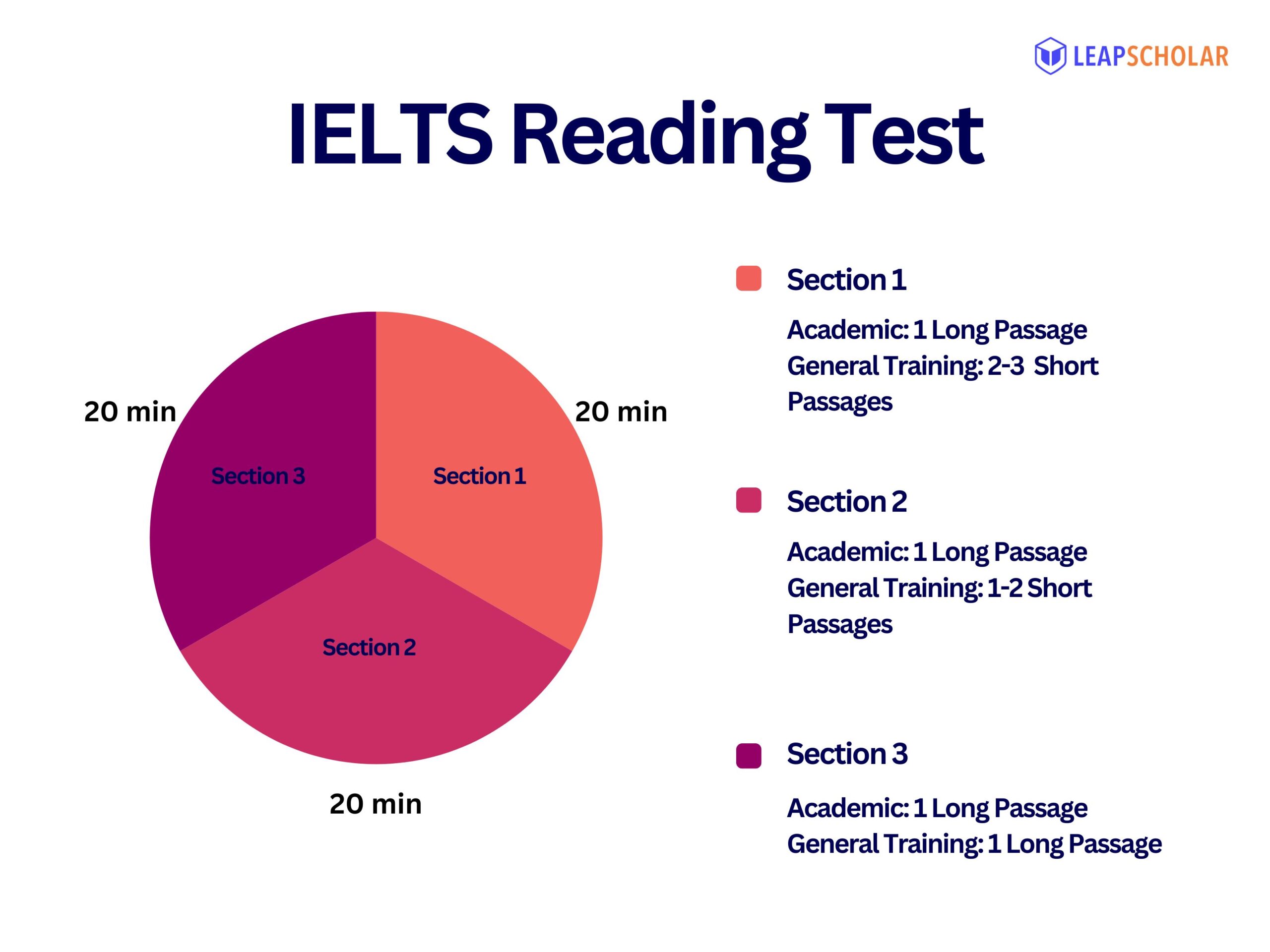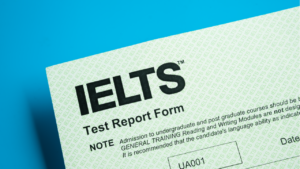Optimise your IELTS Reading test preparation with the Corporate Social Responsibility Reading answers below.
The IELTS, or The International English Language Testing System, is one of the world’s most widely accepted language tests. Consisting of four modules, the test lasts 2 hours and 44 minutes.
The IELTS Reading test assesses your English language reading capacities. The test lasts one hour and it comprises three different sections. Each section will provide a passage, followed by questions based on it.
Check out the details of the IELTS Reading Test:
| Duration | 60 minutes |
| Number of Questions | 40 |
| Number of Section | 3 |
| Number of Passages | Academic: 3 General: 4- 6 |
| Band Score | 1-9 |
| Question Types | – Summary, Notes, Tables, Flow-chart Completion – Diagram Label Completion – Multiple Choice Questions – Matching Information – Matching Headings – Matching Features – Matching Sentence Endings – Sentence Completion – Short-Answer Questions – Identifying Information – Identifying a Writer’s Views/Claims |
The IELTS Reading test consists of three sections. Completing each section within a time of 20 minutes is recommended.

The given passage is on the importance of CSR or Corporate Social Responsibility. It explains the relevance of CSR and how it impacts society and the firms. Read the given passage carefully and answer the questions that follow.
The given passage comprises three question sets:
- IELTS Reading Matching Headings
- IELTS Reading Summary Completion
- IELTS Reading Matching Features
Try answering the questions and then review your answers based on the answer key at the end. You can locate the answers within the passage using the reference provided for each answer. Check out the detailed explanations for more information.
Leap Advantage Virtual Spot Offer Event on May 10th 2024

Last call to secure your spot for Masters in STEM Program in the US for Fall ’24 exclusively for graduates and above.
Leap Advantage Virtual Spot Offer Event on May 10th 2024
Last call to secure your spot for Masters in STEM Program in the US for Fall ’24 exclusively for graduates and above.

Corporate Social Responsibility Reading Passage
Check out the Corporate Social Responsibility reading passage below. Read the passage carefully and answer the following questions.
Corporate Social Responsibility
In general, proponents of CSR have supported their position with four arguments: moral obligation, sustainability, license to operate, and reputation. Business for Social Responsibility, the biggest non-profit CSR business organization in the United States, has as a primary objective the moral argument that corporations must be decent citizens and do the right thing. It requests that its members “achieve business success in methods that respect people, communities, and the natural environment.” Sustainability promotes environmental stewardship and community responsibility.
A. In the 1980s, Norwegian Prime Minister Gro Harlem Brundtland and the World Business Council for Sustainable Development created an outstanding description. “Meeting existing demands without sacrificing future generations’ ability to satisfy their own needs.” Every enterprise needs the tacit or explicit approval of governments, communities, and numerous other stakeholders to operate. Lastly, many organisations utilise reputation to justify CSR activities since they will enhance a company’s image, build its brand, boost morale, and even increase its stock value.
B. To advance CSR, it must be rooted in a broad knowledge of the interaction between business and society while also being anchored in the plans and actions of individual organisations. Interdependence between companies and society may appear to be a cliche, but it is a basic truth that may help firms escape the quicksand created by their current corporate responsibility mindset. A prosperous economy requires a healthy society. Education, health care, and fair opportunity are crucial components of a thriving workforce. In addition to attracting customers, safe goods and working environments reduce the internal costs of accidents. Effective utilisation of land, water, energy, and other natural resources promotes business productivity. Efficiency and creativity require effective governance, the rule of law, and secure property rights. Strong regulatory requirements safeguard against the exploitation of both consumers and competing businesses. As more human needs are addressed, and aspirations increase, a healthy society inevitably generates rising commercial demand. Any organisation that pursues its objectives at the expense of the society in which it operates will enjoy a false and ultimately ephemeral success. Likewise, a healthy society requires prosperous businesses. No social program can compete with the private sector when it comes to generating employment, income, and innovation that sustainably enhances living standards and social circumstances.
C. A company’s influence on society also evolves through time as social norms and science advance. Given the known scientific knowledge in the early 1900s, it was believed that asbestos did not pose a significant health concern. For over fifty years, evidence of its hazards steadily accumulated for any firm to be held accountable for the injuries it could create. Numerous companies that failed to predict the repercussions of this increasing corpus of knowledge have collapsed as a result. Companies can no longer be happy with monitoring merely the most obvious social implications of the present. Without a methodical procedure for recognizing the growing societal implications of the future, businesses may endanger their very survival.
D. No firm can address all of society’s issues or absorb the expenses associated with doing so. Instead, each corporation must choose topics that overlap with its industry. Other social goals should be left to corporations in other industries, non-governmental organisations (NGOs), or government entities that are better equipped to address them. The primary criteria that should lead to corporate social responsibility are not whether a cause is deserving but whether it gives a chance to produce shared value—that is, a substantial benefit for society that is also useful for the firm. However, corporations are neither accountable for nor equipped to tackle all of the world’s issues. Each organisation may identify the specific set of societal issues it is best qualified to assist in resolving and from which it can get the greatest competitive advantage. Creating shared value to address social concerns will result in self-sustaining solutions independent of commercial or government subsidies. A corporation may have a bigger influence on social good than any other institution or philanthropic organisation when it uses its massive resources, experience, and managerial ability to challenge its understanding and in which it has a stake.
E. The most effective corporate citizenship programs require far more than making a check: They outline specific, quantifiable objectives and monitor performance throughout time. GE’s effort to adopt low-performing public high schools around its main U.S. operations is a prime example. The corporation provides between $250,000 and $1,000,000 in cash and in-kind grants to each institution over five years. GE Managers and staff play an active role by collaborating with school authorities to identify student needs and provide mentoring or tutoring. In an independent examination of 10 schools participating in the program between 1989 and 1999, virtually all showed considerable improvement, while the graduation percentage in four of the five lowest-performing schools rose from an average of 30% to 60%. Effective corporate citizenship projects, such as this one, generate goodwill and enhance relationships with local governments and other significant stakeholders. In addition, GE personnel are extremely proud of their engagement. However, their influence is fundamentally restricted. Regardless of how advantageous the program is, it remains incidental to the company’s operation, and its direct impact on GE’s recruitment and retention is small.
F. The Working Connections relationship between Microsoft and the American Association of Community Colleges (AACC) is an excellent illustration of a shared-value potential resulting from investments in context. There are currently more than 450,000 empty IT roles in the United States alone, which poses a substantial growth barrier for Microsoft. Community colleges, which enroll 11,6 million students, or 45 percent of all undergraduates in the United States, might be a key answer. Microsoft acknowledges, however, that community colleges confront unique challenges: IT courses are not standardised, classroom technology is frequently obsolete, and there are no regular faculty professional development programs. Microsoft’s $50 million, five-year program targeted all three issues. In addition to monetary and product donations, Microsoft dispatched staff volunteers to universities to analyse requirements, contribute to curriculum creation, and establish institutes for faculty development. In this instance, volunteers and allocated staff were allowed to apply their primary professional abilities to meet a social need, which is a significant departure from the norm for volunteer programs. Microsoft has accomplished accomplishments that have helped several communities while having a direct and possibly major effect on the firm.
G. At the core of each strategy is a unique value proposition: a set of demands that a firm can fulfill for its selected clients that no other company can. CSR is at its most strategic when a firm adds a social dimension to its value offer and integrates social effect into its entire strategy. Consider Whole Foods Market, whose value proposition is to provide organic, natural, and nutritious food goods to food and environment-conscious customers. Each store’s buying procedure prioritises purchases from local farmers as part of the company’s sourcing strategy. Buyers exclude meals containing any of the almost 100 common additives that the corporation deems unhealthy or harmful to the environment. The same criteria apply to domestically produced goods. The dedication of Whole Foods to natural and ecologically sustainable business practices extends far beyond sourcing. The construction of stores uses a minimum of virgin resources. Recent purchases of renewable wind energy credits offset the firm’s complete power use across all of its shops and facilities, making it the first Fortune 500 company to do so. Produce spoilage and biodegradable garbage are transported to regional composting plants via truck. The cars of Whole Foods are being modified to operate on biofuels. Even the store’s cleaning supplies are ecologically friendly. And via its philanthropic efforts, the corporation has established the Animal Compassion Foundation to pursue more natural and ethical methods of animal husbandry. In conclusion, almost every part of the company’s value chain strengthens the social dimensions of its value proposition, thereby separating Whole Foods from its competitors.
From the 2007 Harvard Business Review
Also Read: IELTS Reading 2023: Valuable Tips to Improve Vocabulary
Questions for Corporate Social Responsibility Reading Passage
Crack IELTS Exam in first attempt

Attend Leap’s free masterclass to get tips, tricks and advance strategies to crack IELTS exam in first attempt
Crack IELTS Exam in first attempt
Attend Leap’s free masterclass to get tips, tricks and advance strategies to crack IELTS exam in first attempt

Questions 1-7
The reading passage has seven paragraphs, A-G
Choose the correct heading for paragraph A-G from the list below.
Write the correct number, i-xi, in boxes 1-7 on your answer sheet.
List of Headings
I. How CSR may help one business to expand
II. CSR in many aspects of a company’s business
III. A CSR initiative without a financial gain
IV. Lack of action by the state on social issues
V. Drives or pressures motivate companies to address CSR
VI. The past illustrates businesses are responsible for future outcomes
VII. Companies applying CSR should be selective
VIII. Reasons that business and society benefit each other
1. Paragraph A
2. Paragraph B
3. Paragraph C
4. Paragraph D
5. Paragraph E
6. Paragraph F
7. Paragraph G
Questions 8-9
Complete the following summary of the paragraphs of the reading passage, using NO MORE THAN TWO WORDS from the reading passage for each answer.
Write your answers in boxes 8-9 on your answer sheet.
The implementation of CSR, HOW?
The promotion of CSR requires an understanding of the interdependence between business and society. Corporation workers’ productivity generally needs health care, Education, and given 9…………… Restrictions imposed by the government and companies both protect consumers from being treated unfairly. Improvement of the safety standard can reduce 9 …………… accidents in the workplace. Similarly, society becomes a pool of more human needs and aspirations.
Questions 10-13
Use the information in the passage to match the companies (listed A-C) with opinions or deeds below.
Write the appropriate letters A, B, or C in boxes 10-13 on your answer sheet.
List of companies
A. General Electronics
B. Microsoft
C. Whole Foods Market
10. The disposable waste
11. The way a company purchases goods
12. Helping the undeveloped
13. ensuring the people have the latest information
Corporate Social Responsibility Reading Answers and Explanations
1. Answer:
V. Drives or pressures motivate companies to address CSR
Reference:
Paragraph A: Every enterprise needs the tacit or explicit approval of governments, communities, and numerous other stakeholders to operate. Lastly, many organisations utilise reputation to justify CSR activities since they will enhance a company’s image, build its brand, boost morale, and even increase its stock value.
Explanation:
The given passage explains the importance of corporate social responsibility. According to the above-given lines, the government and other social pressures motivate companies to address CSR or corporate social responsibility. Addressing CSR has become a matter of reputation and sustenance of a firm. So, the title drives or pressures motivate companies to address CSR matches paragraph A.
2. Answer:
VIII. Reasons that business and society benefit each other
Reference:
Paragraph B: Interdependence between companies and society may appear to be a cliche, but it is a basic truth that may help firms escape the quicksand created by their current corporate responsibility mindset. A prosperous economy requires a healthy society.
Explanation:
According to the given lines, companies and societies have a huge interdependence. Any firm requires a prosperous economy to flourish, and for the growth of any economy, it is crucial to have a healthy society. So, the title reasons that business and society benefit each other matches paragraph B.
3. Answer:
VI. The past illustrates businesses are responsible for future outcomes
Reference:
Paragraph C: Companies can no longer be happy with monitoring merely the most obvious social implications of the present. Without a methodical procedure for recognizing the growing societal implications of the future, businesses may endanger their very survival.
Explanation:
According to the given lines, corporate social responsibility does not just mean prioritising the social and ethical values of the present. It is equally important to address the future implications of the company policies. So, the title past illustrates businesses are responsible for future outcomes matches paragraph C.
4. Answer:
VII. Companies applying CSR should be selective
Reference:
Paragraph D: No firm can address all of society’s issues or absorb the expenses associated with doing so. Instead, each corporation must choose topics that overlap with its industry. Other social goals should be left to corporations in other industries, non-governmental organisations (NGOs), or government entities that are better equipped to address them.
Explanation:
The passage explains that a company can’t address all social and ethical concerns. So, it has to be selective about its choices. Each firm should prioritise the factors that affect it the most. The other matters should be left to other firms and governmental and non-governmental organisations. So, title companies applying CSR should be selective matches paragraph D.
5. Answer:
III. A CSR initiative without a financial gain
Reference:
Paragraph E: GE’s effort to adopt low-performing public high schools around its main U.S. operations is a prime example. The corporation provides between $250,000 and $1,000,000 in cash and in-kind grants to each institution over five years… Regardless of how advantageous the program is, it remains incidental to the company’s operation, and its direct impact on GE’s recruitment and retention is small.
Explanation:
According to the given passage, GE’s initiative to promote backward public high schools has major implications for improving the quality of education in the institutions. However, it does not provide much financial gain for the organisation. So, the title CSR initiative without a financial gain matches paragraph E.
6. Answer:
I. How CSR may help one business to expand
Reference:
Paragraph F: The Working Connections relationship between Microsoft and the American Association of Community Colleges (AACC) is an excellent illustration of a shared-value potential resulting from investments in context.
Explanation:
According to the passage, joint initiatives between companies can help firms flourish. The example mentioned here is that between Microsoft and the American Association of Community Colleges (AACC). So, the title of how CSR may help one business to expand matches with paragraph F.
7. Answer:
II. CSR in many aspects of a company’s business
Reference:
Paragraph G: The dedication of Whole Foods to natural and ecologically sustainable business practices extends far beyond sourcing… And via its philanthropic efforts, the corporation has established the Animal Compassion Foundation to pursue more natural and ethical methods of animal husbandry. In conclusion, almost every part of the company’s value chain strengthens the social dimensions of its value proposition, thereby separating Whole Foods from its competitors.
Explanation:
According to the final paragraph of the passage, Whole Foods is an excellent example of how a company applied CSR in more than one aspect of its business. Whole Foods not only relies on domestic producers for its stock but uses renewable energy sources for its consumption. So, the title CSR in many aspects of a company’s business matches precisely with paragraph G.
8. Answer:
Fair Opportunity
Reference:
From paragraph B: A prosperous economy requires a healthy society. Education, health care, and fair opportunity are crucial components of a thriving workforce.
Explanation:
According to the passage, it is essential to provide enough education, healthcare, and equal opportunities for all within the corporate sector. This directly impacts the quality of the production within the company.
9. Answer:
Internal costs
Reference:
From paragraph B: In addition to attracting customers, safe goods and working environments reduce the internal costs of accidents.
Explanation:
According to the passage, ensuring fair opportunities, education, and healthcare can not only attract customers but also reduce the probability of internal risks of accidents. Providing safe goods and a safe working environment is essential for any firm.
10. Answer:
C – Whole Foods Market
Reference:
From paragraph G: Produce spoilage and biodegradable garbage are transported to regional composting plants via truck. The cars of Whole Foods are being modified to operate on biofuels.
Explanation:
The above-given lines indicate that Whole Foods Market produces disposable waste. These biodegradable garbage are then transported for composting. So, the option ‘disposable waste’ matches with the company Whole Foods Market.
11. Answer:
C – Whole Foods Market
Reference:
From paragraph G: Consider Whole Foods Market, whose value proposition is to provide organic, natural, and nutritious food goods to food and environment-conscious customers. Each store’s buying procedure prioritises purchases from local farmers as part of the company’s sourcing strategy.
Explanation:
The final paragraph of the passage explains how Whole Foods Market practices CSR. One of its health initiatives is the way the company purchases its goods. It prioritises the local farmers and other producers while purchasing its goods.
12. Answer:
A – General Electronics
Reference:
From paragraph E: GE’s effort to adopt low-performing public high schools around its main U.S. operations is a prime example. The corporation provides between $250,000 and $1,000,000 in cash and in-kind grants to each institution over five years. GE Managers and staff play an active role by collaborating with school authorities to identify student needs and provide mentoring or tutoring.
Explanation:
According to the passage, General Electronics helps identify and develop students who need proper mentoring. It prioritises needy students by working in partnership with low-performing high schools.
13. Answer:
B – Microsoft
Reference:
From paragraph F: The Working Connections relationship between Microsoft and the American Association of Community Colleges (AACC) is an excellent illustration of a shared-value potential resulting from investments in context… Microsoft has accomplished accomplishments that have helped several communities while having a direct and possibly major effect on the firm.
Explanation:
According to the passage, the shared bond between Microsoft and the American Association of Community Colleges (AACC) has benefited both organisations. While Microsoft monitored the educational standards of the institutions, they provided ample workforce for the firm.
Try More Reading Passages
- The Flavour of Pleasure Reading Answers
- Bird Migration Reading Answers
- South Pole Adventurer Reading Answers 2024
- The Forgotten Forests Reading Answers
- Henry Moore Reading Answers
- Why We Need to Protect Polar Bears Reading Answers
- Coastal Archaeology of Britain Reading Answers
- The Power of Play Reading Answers
- Could Urban Engineers Learn from Dance Reading Answers
Conclusion
While IELTS Reading is only one of the four modules of the IELTS test, it directly contributes to your overall score on the test. Your IELTS score is the net total of the individual band score from each module. So, it is important you prepare well for your IELTS Reading test.
Attempting sample papers, mock tests, and other IELTS resources is essential during your IELTS Reading preparation. Solving more reading passages will help you get acquainted with the texts and question sets and help you practice managing time effectively during the test.
The average preparation time for the IELTS test is 2-3 months. But, it is crucial that you get proper guidance and credible resources for your preparation. Leap’s IELTS Experts can provide quality classes, practice sessions and other IELTS resources. Make sure you invest your preparation time wisely.
Frequently Asked Questions
-
Q. How can I improve my reading skills?
A. The most efficient practice to improve your reading skills is through cultivating a regular reading habit. Try to read new and different types of texts. You can read daily newspapers, entertainment magazines, novels and even academic textbooks. Try to attempt reading passages and solving them within the given time.
-
Q. What are some excellent books for IELTS Reading?
A. Some of the good resources for IELTS Reading preparation are:
– The Official Cambridge Guide to IELTS
– Target 9 Latest Reading test (2022 – 2023)
– IELTS Reading Academic ( 15 Advanced Level Tests) by Darshan Singh
– Makkar IELTS English for Exams IELTS
– Academic Reading Vol.1 and Vol.2 by Dr Kiranpreet Kaur Makkar -
Q. What is the minimum preparation time for the IELTS Reading test?
A. The generation preparation time for the IELTS test is 2-3 months. You can reserve 15-20 days for your IELTS Reading preparation. However, your preparation time can vary depending on several factors, including your current level, daily available time and concentration level. Plan your preparation time considering all these.
-
Q. Can I get free IELTS Reading resources online?
A. Yes, you can get free IELTS Reading resources online. You can depend on the IDP website and other official websites for help. But make sure you rely on credible sources. You can get IELTS Reading resources, practice sessions and mock tests from Leap IELTS Trainers.
-
Q. which are good IELTS books for grammar?
A. Some of the good suggestions are:
– Cambridge Grammar for IELTS
– Oxford Practice Grammar Advanced, G.Yule (Oxford)
– English Grammar in Use Book with Answers, R. Murphy (Cambridge).
– IELTS Topic Vocabulary: Essential Vocabulary for Speaking and Writing Exams by Peter Killingley and Mary E. Kuder -
Q. What are some good books for IELTS Speaking preparation?
A. If you are preparing for the IELTS Speaking test, then you can refer to the following texts:
– Target 9 Lastest 2022 Edition IELTS Speaking by Darshan Singh
– The Masterpiece of Speaking IELTS by Vinod Gambtoo
– Parthesh Thakka’s The Ultimate Guide to IELTS Speaking
– The Official Cambridge Guide to IELTS -
Q. What are some good tips for IELTS Reading preparation?
A. Given are some good practices for your IELTS Reading preparation:
– Read different kinds of texts regularly
– Try learning new words
– Try to learn more synonyms for a word
– While learning new terms, try to apply them in sentences and use them in your daily life
– Learn the commonly confused words such as ‘quite and quiet’ or ‘lose and loose’ -
Q. Can spelling mistakes affect my IELTS Reading score?
A. Yes, spelling mistakes can be penalised during your IELTS Reading test. Since the IELTS is a language proficiency test, it assesses your language capabilities to answer completely and comprehensively. Making spelling mistakes can affect your score.
-
Q. Is obeying the word limit compulsory for the IELTS Reading test?
A. Yes, obeying the word limit for your IELTS Reading test is compulsory. If the questions instruct you to answer within a specific word limit, then do not exceed the limit at any cost. Writing beyond the specified word limit will affect your score.
-
Q. What are the commonly asked question types for the IELTS Reading test?
A. The different question types for your IELTS Reading test are:
– Multiple Choice Questions
– Matching Information
– True or False Questions
– Matching Questions
– Plan/Map/Diagram Labelling Questions
– Table Completion
– Identifying information
– Form/Note/Table/Flowchart/Summary Completion Questions
– Sentence Completion Questions
– Short-Answer Questions -
Q. Can I skip questions during my IELTS Reading test?
A. Yes, you can skip questions during your IELTS Reading test. It is not necessary to attempt all the questions. However, it is recommended that you try as many as possible since you do not have any negative marking system for the IELTS.







